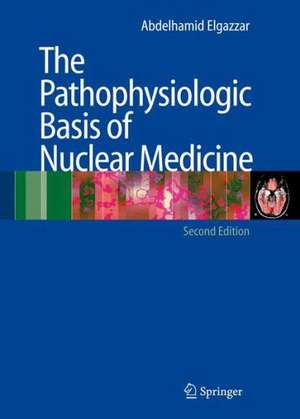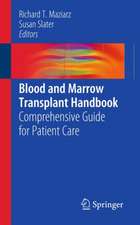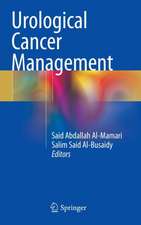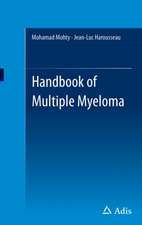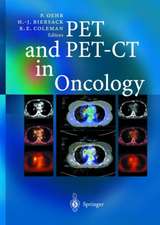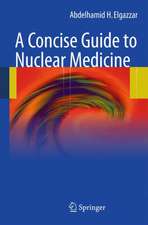The Pathophysiologic Basis of Nuclear Medicine
Editat de Abdelhamid H. Elgazzaren Limba Engleză Paperback – 12 feb 2010
| Toate formatele și edițiile | Preț | Express |
|---|---|---|
| Paperback (3) | 1112.30 lei 6-8 săpt. | |
| Springer International Publishing – 10 iul 2023 | 1112.30 lei 6-8 săpt. | |
| Springer International Publishing – 25 sep 2014 | 1113.12 lei 38-44 zile | |
| Springer Berlin, Heidelberg – 12 feb 2010 | 2307.55 lei 6-8 săpt. | |
| Hardback (1) | 1630.55 lei 3-5 săpt. | |
| Springer International Publishing – 9 iul 2022 | 1630.55 lei 3-5 săpt. |
Preț: 2307.55 lei
Preț vechi: 2429.01 lei
-5% Nou
Puncte Express: 3461
Preț estimativ în valută:
441.81€ • 453.21$ • 371.98£
441.81€ • 453.21$ • 371.98£
Carte tipărită la comandă
Livrare economică 26 februarie-12 martie
Preluare comenzi: 021 569.72.76
Specificații
ISBN-13: 9783642063107
ISBN-10: 3642063101
Pagini: 584
Ilustrații: XV, 566 p.
Dimensiuni: 193 x 270 x 31 mm
Greutate: 1.36 kg
Ediția:Softcover reprint of hardcover 2nd ed. 2006
Editura: Springer Berlin, Heidelberg
Colecția Springer
Locul publicării:Berlin, Heidelberg, Germany
ISBN-10: 3642063101
Pagini: 584
Ilustrații: XV, 566 p.
Dimensiuni: 193 x 270 x 31 mm
Greutate: 1.36 kg
Ediția:Softcover reprint of hardcover 2nd ed. 2006
Editura: Springer Berlin, Heidelberg
Colecția Springer
Locul publicării:Berlin, Heidelberg, Germany
Public țintă
Professional/practitionerCuprins
The Cell: Structure, Function, and Molecular Biology.- Pathophysiology and Mechanisms of Radiopharmaceutical Localization.- Basis of 18F-FDG Positron Emission Tomography Imaging.- Inflammation.- Nuclear Hematology.- Musculoskeletal System.- Thyroid Gland.- Parathyroid Gland.- Adrenal Gland.- Basis of Renal Scintigraphy.- Basis of Tumor Imaging 1: Principles of Tumor Pathology and Biology.- Basis of Tumor Imaging 2: Scintigraphic and Pathophysiologic Correlation.- Respiratory System.- Basis of Cardiac Imaging 1: Myocardial Contractility and Assessment of Cardiac Function.- Basis of Cardiac Imaging 2: Myocardial Perfusion, Metabolism, Infarction, and Receptor Imaging in Coronary Artery Disease and Congestive Heart Failure.- Digestive System 1: Gastrointestinal Tract.- Digestive System 2: Liver and Biliary Tract.- Basis and Clinical Application of Brain Imaging.- Basis of Antibody Imaging and Therapy.- Lymphoscintigraphy.- Basis of Pediatric Genitourinary Imaging.- Basis of Therapeutic Nuclear Medicine.- Biological Effects of Ionizing Radiation.
Recenzii
Radiology Review:
"The Pathophysiologic Basis of Nuclear Medicine, second edition, is one of the most in-depth and comprehensive textbooks on nuclear medicine. It considers the clinical problems of patients using available historical and laboratory data and then recommends a problem solving approach with nuclear medicine. The author is especially qualified to edit this textbook, as he is trained in both pathology and nuclear medicine. His depth of knowledge in the pathologic basis of disease and his many clinical insights are evident throughout this textbook. ... This attractively designed and illustrated hardbound textbook contains 23 chapters of well-organized material that is clearly and succinctly written. ... The book clearly illustrates how to advance one's diagnostic reading skills by combining physiologic information with high-quality nuclear medicine examinations. The Pathophysiologic Basis of Nuclear Medicine is a 'must have' book for all professionals dealing with nuclear medicine procedures. ... " (Michael J. Blend, PhD, DO; Radiology Feb 2008)
"The Pathophysiologic Basis of Nuclear Medicine, second edition, is one of the most in-depth and comprehensive textbooks on nuclear medicine. It considers the clinical problems of patients using available historical and laboratory data and then recommends a problem solving approach with nuclear medicine. The author is especially qualified to edit this textbook, as he is trained in both pathology and nuclear medicine. His depth of knowledge in the pathologic basis of disease and his many clinical insights are evident throughout this textbook. ... This attractively designed and illustrated hardbound textbook contains 23 chapters of well-organized material that is clearly and succinctly written. ... The book clearly illustrates how to advance one's diagnostic reading skills by combining physiologic information with high-quality nuclear medicine examinations. The Pathophysiologic Basis of Nuclear Medicine is a 'must have' book for all professionals dealing with nuclear medicine procedures. ... " (Michael J. Blend, PhD, DO; Radiology Feb 2008)
Caracteristici
Significantly enlarged new edition More clinically oriented details on scintigraphic studies Many new images, illustrations and tables
Notă biografică
Abdelhamid H. Elgazzar graduated from the University of Cairo, School of Medicine, Cairo, Egypt. He received his training in Clinical and Anatomic Pathology at the University of Kansas, School Of Medicine and his Nuclear Medicine training at the University of Cincinnati, School Of Medicine, Cincinnati, Ohio, USA.
Professor Elgazzar is board certified by the American Board of Anatomical and Clinical Pathology as well as by the American Board of Nuclear Medicine. In addition to that he is a fellow of the College of American Pathologists. He worked as a faculty staff at the University of Cincinnati School of Medicine, the Mount Sinai School of Medicine, New York and as a Head of Nuclear Medicine Department at Tufts Medical Center, Boston.
Currently, Professor Elgazzar is a professor and chairman of the Nuclear Medicine Department at Kuwait University. During his career he has received 14 awards from several international professional organizations.
He is member of the editorial board of several medical journals and has authored and co-authored more than 150 peer-reviewed scientific articles and has authored and edited 10 textbooks and six book chapters. In addition to that, he has served as a reviewer of the Journal of Nuclear Medicine and several other medical journals.
Professor Elgazzar is board certified by the American Board of Anatomical and Clinical Pathology as well as by the American Board of Nuclear Medicine. In addition to that he is a fellow of the College of American Pathologists. He worked as a faculty staff at the University of Cincinnati School of Medicine, the Mount Sinai School of Medicine, New York and as a Head of Nuclear Medicine Department at Tufts Medical Center, Boston.
Currently, Professor Elgazzar is a professor and chairman of the Nuclear Medicine Department at Kuwait University. During his career he has received 14 awards from several international professional organizations.
He is member of the editorial board of several medical journals and has authored and co-authored more than 150 peer-reviewed scientific articles and has authored and edited 10 textbooks and six book chapters. In addition to that, he has served as a reviewer of the Journal of Nuclear Medicine and several other medical journals.
Textul de pe ultima copertă
This book, now in its third edition, aims to promote a deeper understanding of the scientific and clinical basis of nuclear medicine and the new directions in medical imaging, which will lead to better utilization of nuclear medicine techniques in patient management and to further modifications and innovations in the field. The new edition has been revised and updated to reflect recent changes and to ensure that the contents are in line with likely future directions.
The book starts by providing essential basic information on general pathophysiology, cell structure, and cell biology as well as the mechanisms of radiopharmaceutical localization in different tissues and cells. The clinical applications of nuclear medicine are then presented in a series of chapters covering every major organ system. These chapters relate the basic relevant knowledge of anatomy, physiology, and pathology to the clinical utilization of various scintigraphic modalities. The therapeutic applications of nuclear medicine, including recent advances, are discussed in a separate chapter. The final chapter is devoted to the biologic effects of ionizing radiations, including radiation from medical procedures. A glossary at the end of the book has been expanded with clear explanations of certain terms and uncommon disease conditions that will help students and trainees in understanding pertinent concepts.
It is hoped that this book will continue to help nuclear medicine practitioners, trainees, students, and researchers, as well as professionals in various other medical fields.
The book starts by providing essential basic information on general pathophysiology, cell structure, and cell biology as well as the mechanisms of radiopharmaceutical localization in different tissues and cells. The clinical applications of nuclear medicine are then presented in a series of chapters covering every major organ system. These chapters relate the basic relevant knowledge of anatomy, physiology, and pathology to the clinical utilization of various scintigraphic modalities. The therapeutic applications of nuclear medicine, including recent advances, are discussed in a separate chapter. The final chapter is devoted to the biologic effects of ionizing radiations, including radiation from medical procedures. A glossary at the end of the book has been expanded with clear explanations of certain terms and uncommon disease conditions that will help students and trainees in understanding pertinent concepts.
It is hoped that this book will continue to help nuclear medicine practitioners, trainees, students, and researchers, as well as professionals in various other medical fields.
